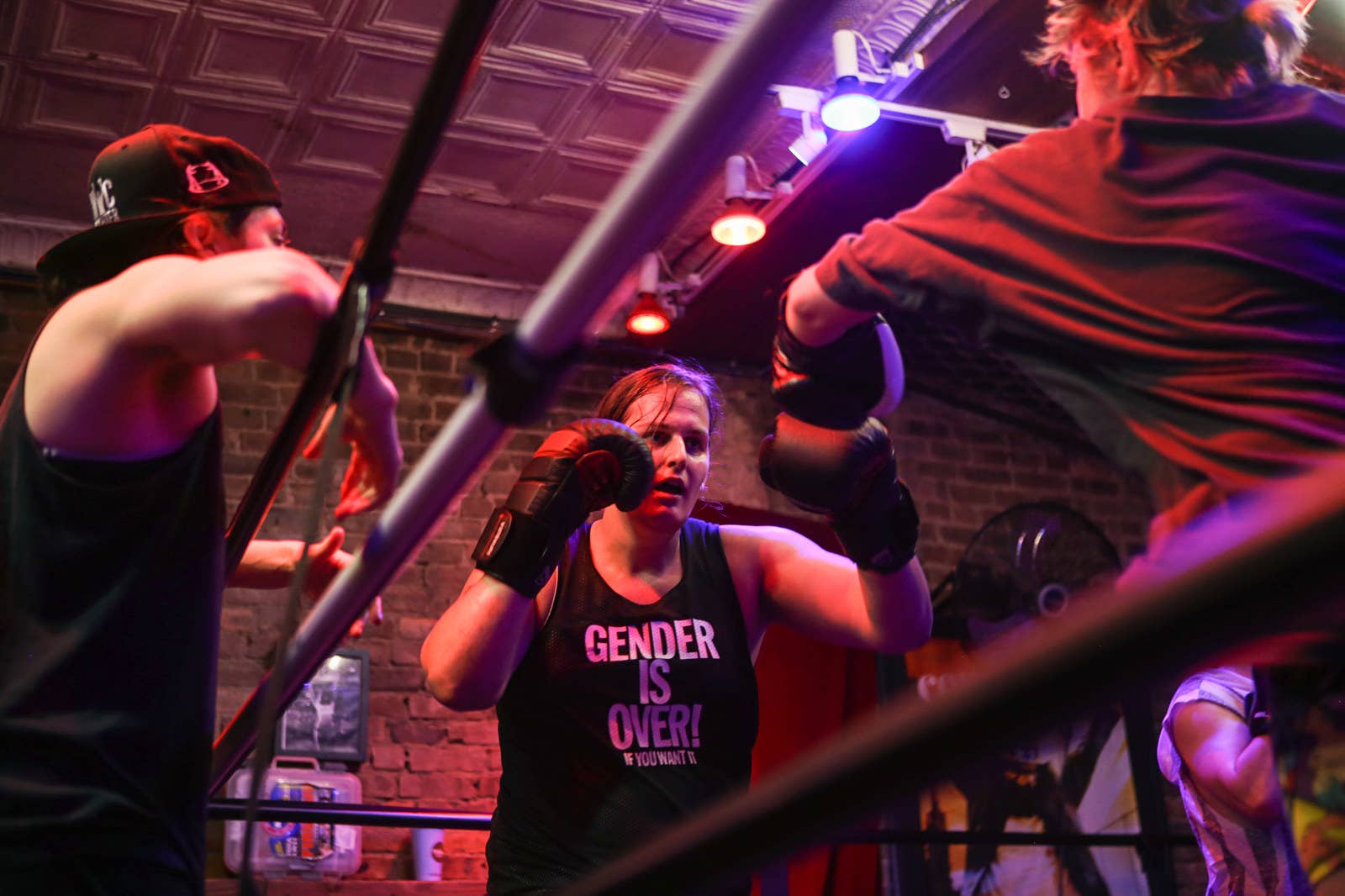
Two boxers face each other beneath a tiny crystal chandelier, skin and gloves lit up in primary colors. Nola Hanson, who’s half of the size of Muhammad Ali but walks through the world with something like his casually worn, hard-won confidence, holds up two padded palms. Nicky Smith, a 23-year-old boxer with close-cropped dandelion hair, aims a gloved fist that flies into Hanson’s open hand like an envoy: trying to determine where everything that follows should land.
As they wind through the ring, Smith tries to maintain eye contact while steadily directing punches.
“Keep your hands up, that’s good,” Hanson says, voice calm and firm. “Don’t look down — that’s it, come on!”
Smith and Hanson are members of the Transgender Boxing Collective, a group of transgender, gender-nonconforming, and nonbinary amateurs who meet once a week at Overthrow Boxing Club in downtown Manhattan. The building used to be owned by the Youth International Party, a countercultural movement from the ’60s. Now it’s a boxing gym for the Instagram era: all neon signs and vintage posters and stage lights. The Transgender Boxing Collective rents space for an hour at a steeply discounted fee; they get room to train, and the gym can claim residual ties to its transgressive roots. In thick white letters, on a brick wall leading down to the basement training room, are the words “The only way to support a revolution is to make your own.”
Hanson, who uses the pronouns they/them, created the Transgender Boxing Collective in July 2017. Fourteen people showed up to the first class, and 20 or so come regularly to the weekly meetings, but some sessions have drawn nearly five times that many. Outside Overthrow, the boxers work as students, artists, and service and social workers. As soon as they cross the gym’s threshold, members head upstairs to the changing room, where Hanson takes care to tape a sign that says “All-Gender Locker Room” prior to each class.
Before practice begins, Hanson patiently helps the boxers wind colorful athletic wraps across their palms and through their fingers. This helps hold together the delicate bones that web across the back of a hand, and prevents muscles from going too slack or too rigid. Most of the group’s members are novices to the sport, and in addition to borrowing wraps they need guidance administering them. As the leader, and one of the more experienced boxers in the group, that task of binding and protecting often falls to Hanson.
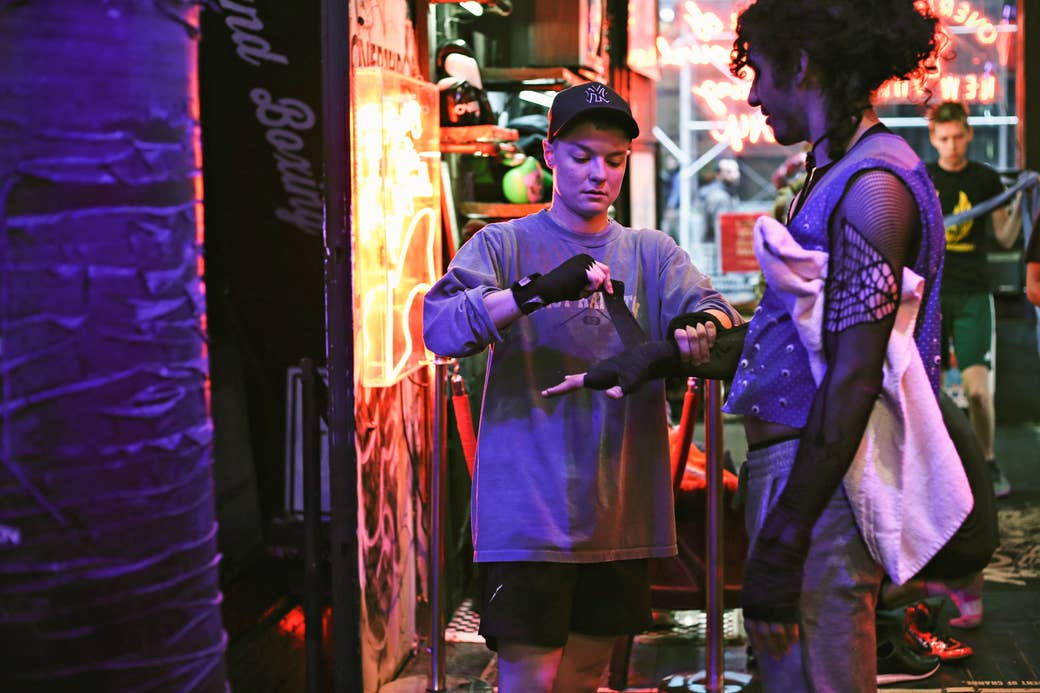
Living as a trans or nonbinary person, Hanson said, means coming up against aggression in ways large and small. There are “tons of microaggressions and oppressive environments we have to deal with,” Hanson said. “And there’s not a clear-cut answer for how to deal with it. Something like boxing is really freeing, because it’s like, OK, this is why you got hurt. To make sure that doesn’t happen again, here’s what you do.”
Thus far the collective has drawn participants largely through postings in queer Facebook groups and word of mouth. All of the boxers identify as transgender or gender-nonconforming, meaning that — unlike those who are cisgender, or “cis”— they do not identify with whatever gender they were assigned at birth. Those who are gender-nonconforming might identify with multiple genders, or with no gender at all.
The larger sporting world, on the other hand, stubbornly sticks to the gender binary, and the professional arena can be difficult to navigate for trans athletes. Boxing in particular is a space usually coded as masculine; it was the last sport in the Olympics to remain all-male, and USA Boxing had a males-only policy until 1993. Boxing is in many ways similar to wrestling (weight classes, theatrical television programming, the decisive crash of one body against another), but the former looms much larger in the American psyche. It has always been considered more violent, more masculine — the sporting world’s antihero.
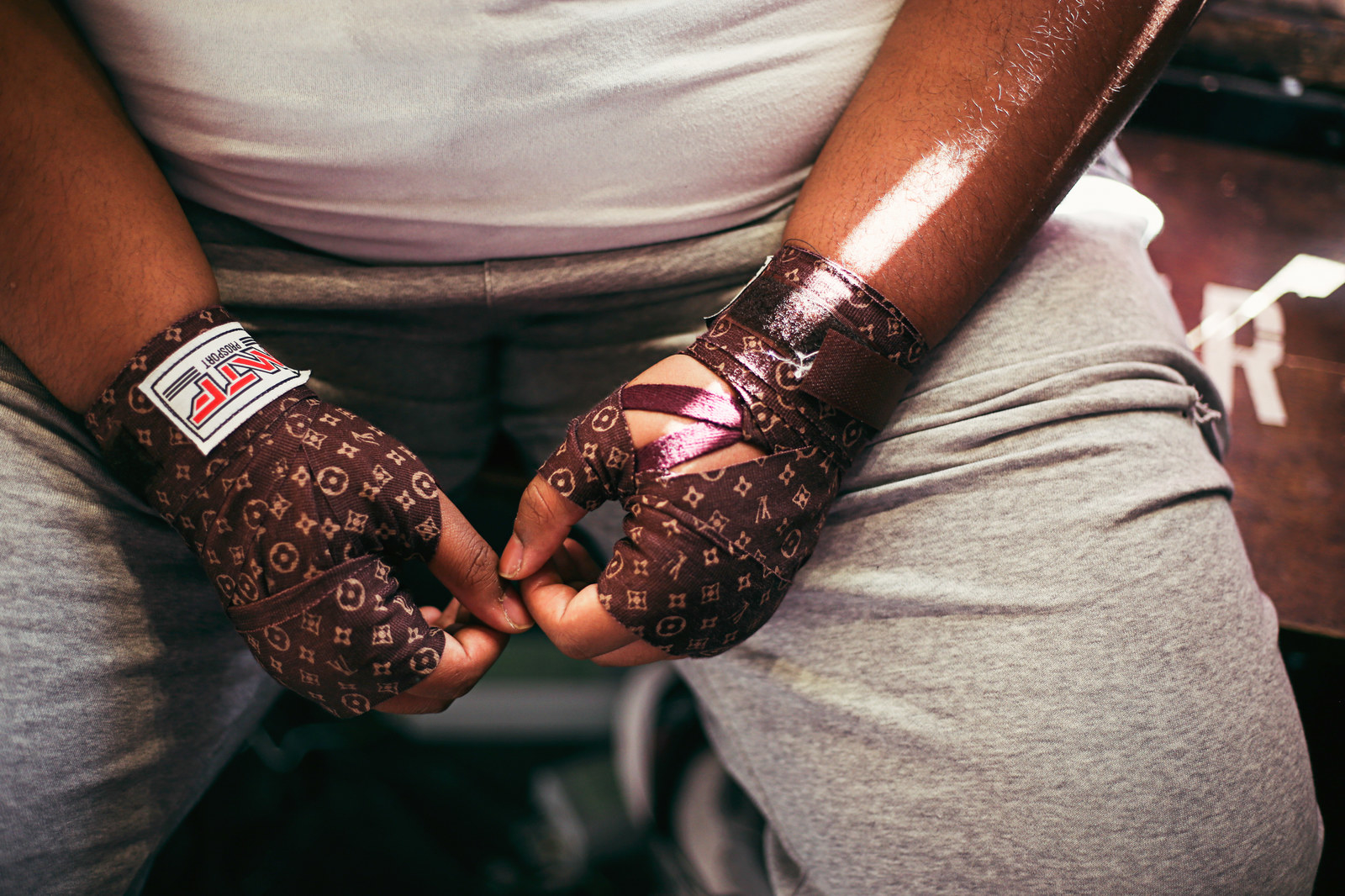
Of course, the majority of the collective’s members, who are just starting out, aren’t looking to go pro or training to win a Golden Glove. True sparring in a ring — the kind where fists meet cheekbones — is still beyond what they are ready for: Hanson and Liv, the collective’s trainer, insist that members show up regularly and get plenty of practice before they can spar, and the few who do wear protective headgear. During most practices, Liv runs defense drills in pairs or has participants practice punches on the overfed black bags that hang from the ceiling.
“I think a lot of what you get at more traditional boxing gyms is this really rigorous, harshly critical training that does help get people to pros and amateur fights, but the collective is a little different,” Hanson told me. “We have the freedom to not really approach folks that way.”
What’s at stake for these amateurs, rather than prize money or televised glory, is something more personal, and more interior. Boxing has become a way for the collective’s members to bend and shape their own understandings of the masculine, the feminine, and the in-between. It’s a way to reckon with their shape and muscle, and with who they are within their bodies. Hanson’s aim — the long game — is getting the collective’s members to embrace the visceral paradox all boxers must grapple with: that in order to become unbound by the body, one must be able and willing to inhabit it.
“Whether it’s ourselves or outside things, it’s hard to feel in control of your body,” said Anna L, a graphic designer who has been a regular participant in the collective since the fall. “I feel like when we’re boxing, especially as I get better and better at it, it’s nice to feel in control. To feel like this is mine, and I own it.”

After practice on a chilly evening in late spring, 15 aspiring boxers slowly filtered into a café close to Overthrow for the collective’s quarterly meeting. Many were coming from a bar nearby, where members usually cluster to drink and talk after taking swings at each other.
Hanson distributed the agenda, which covered issues ranging from allowing cis women to train members to holding targeted workshops for certain underrepresented groups. Many in the collective identify as trans-masculine or, as Smith put it, “masc of center,” and the collective also wanted to discuss potential ways to carve out space for those who were more feminine-identifying.
As everyone waited to begin, the assembled members occupied themselves by jovially roasting Hanson’s BlackBerry. “I don’t think you can even look at Tumblr porn on that thing,” said Liv, a native New Yorker with a deadpan sense of humor. Liv lives and breathes boxing: When they aren’t sparring or working out at the famed Gleason’s Gym, they work as a professional trainer at three different gyms in the city.
Once the table was full and the ribbing had died down, Hanson started the meeting. One of the first topics on the docket was how to keep the collective afloat. Currently, it runs on donations, either via Venmo or bills tossed into a metal bucket on Overthrow’s counter. Hanson often pays Overthrow’s fees up front out of their own pocket and just hopes they’ll be reimbursed later. A few members suggested frequent reminders at the end of class or sending out occasional follow-up emails.
In the classic boxing gym, Hanson said, “there’s no room for debate, it’s not a democratic space, there’s no back-and-forth.” The collective, on the other hand, is more or less a democracy, and all present had a say at the meeting. But by virtue both of founding and organizing the collective, Hanson is clearly the one in charge. They have an athlete’s insouciance, an ease with their body and words that extends beyond the ring. They lean wide in a chair, slinging an arm over the back, with the fluid motion of someone who knows exactly how they intend to cut through and take up space.
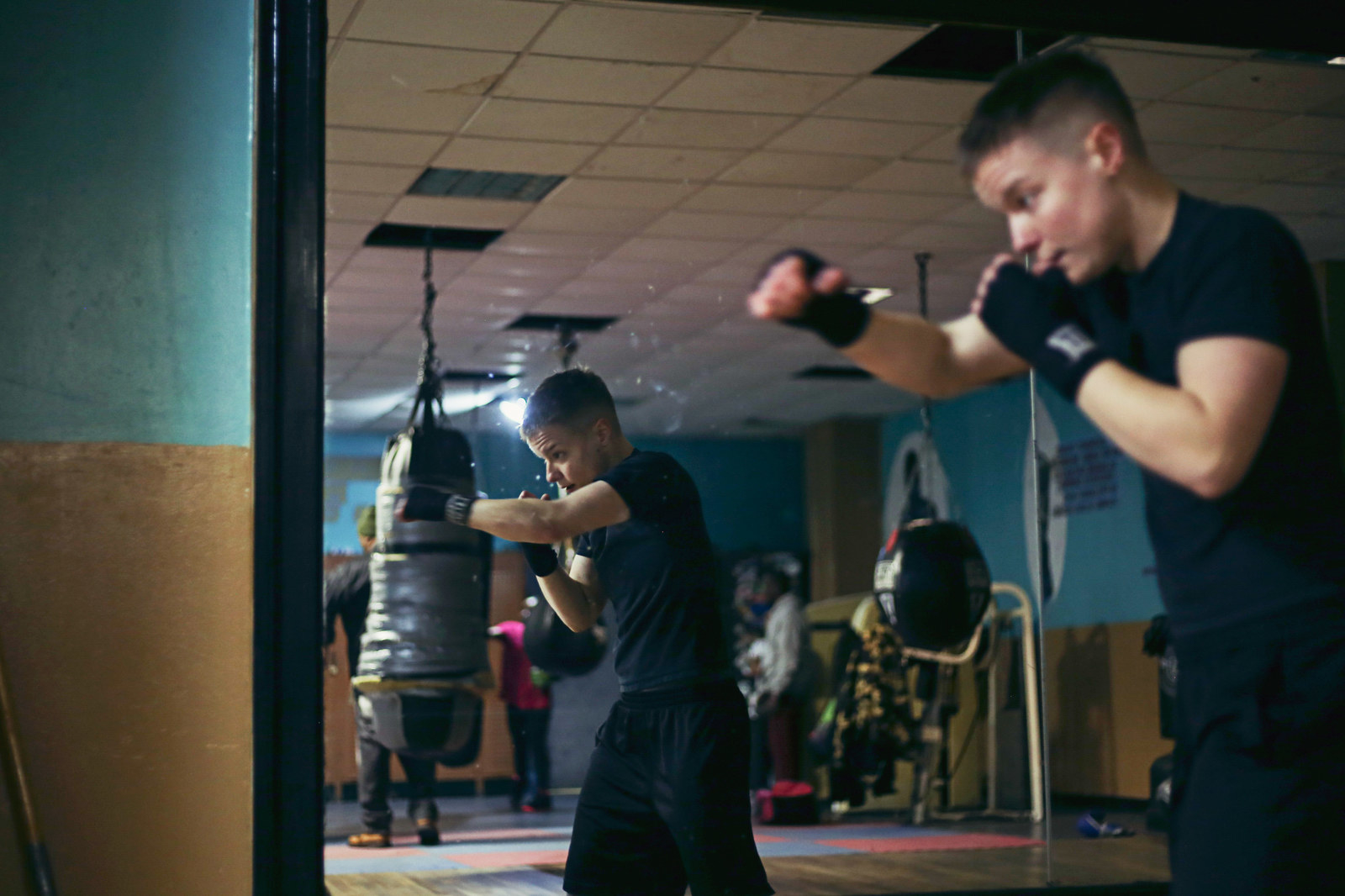
Hanson has an identical twin, a cis woman, and when both were in utero their mother assumed that Hanson would be a boy: a prescient foreshadowing that Hanson describes as “fucking weird.”
“Ever since I was a baby, since I could talk, express myself, it was boys everything,” they said. While playing house, Hanson would insist on being the dad or the brother. They refused to wear dresses or bows. But, Hanson said, “I knew I wasn’t a boy. I knew who boys were, and I knew I wasn’t one, but I didn’t feel like a girl, either.”
Hanson had always been into sports, skateboarding and playing basketball as a kid. After moving to New York from their hometown in Wisconsin, they joined a basketball league for gay women. But Hanson never felt like they belonged there — in large part because the label of girl, or woman, didn’t fit any better than it had when they were a toddler. Boxing, on the other hand, allowed them to be an individual still figuring things out.
“It was always something I was drawn to,” they said. “I found the gym I’m at now, and I just started going every night after work.” At the time, they weren’t sure if they wanted to continue working in a studio as a visual artist, which felt increasingly isolating and unrewarding. “But going into the gym and developing a skill, a craft, and seeing myself improve — being in my body in that way was something I wanted to do,” said Hanson.
When they began to box in earnest two years ago, Hanson was drawn to the sport because of its communion between mind and body: the way it could rewrite muscle memory so that when faced with any threat their first instincts wouldn’t be of fear, or even anger, but rather of clarity. Boxing requires calibrating the body by degrees. If a fist is not where it’s supposed to be, if an elbow is 30 degrees askew, there will be a price to pay, calculated in bruising. It becomes impossible to shut off or disregard one’s body when it is being used so deliberately.
“I started to realize how the sport was benefiting me, and I couldn’t unsee who was excluded and denied access from that,” Hanson said. So they decided to create a space that would encourage other trans and nonbinary people to take up boxing, and to grapple with their bodies in the way Hanson had begun to do.
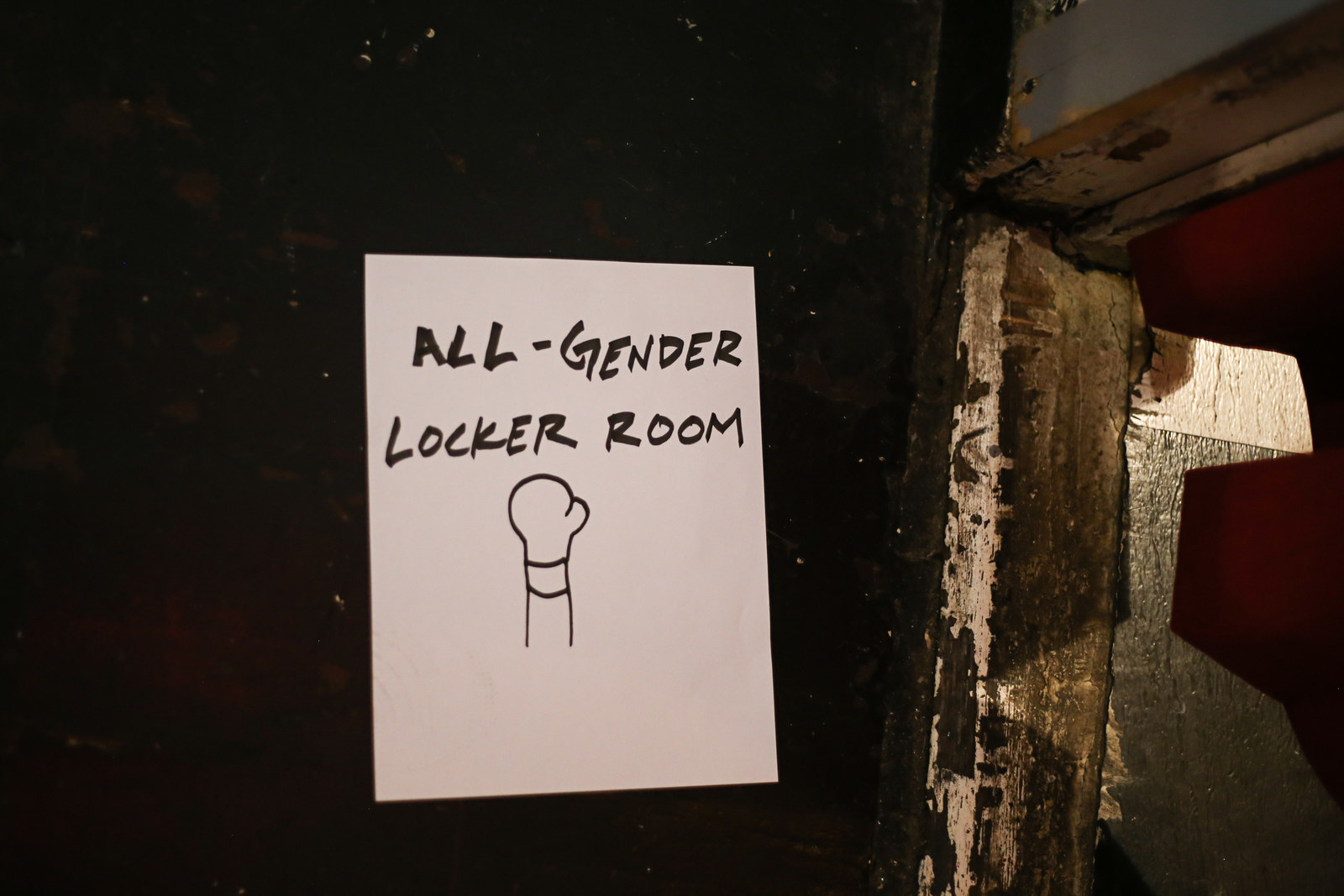
“I’m a pretty gentle person,” Anna tells me on an early midwinter morning, seated inside a voluminous white tent in Bryant Park. Looking at Anna, who is quiet and petite and smiles easily, a casual observer would have no reason to think otherwise. But, they said, when it comes to boxing, “it’s just fun to hit stuff: hit the pads and let out energy in that way.”
Anna is no stranger to martial arts, having done karate for a decade, but felt constrained by the uniforms, belts, and ranking system: what they termed “military discipline.” And while they had been itching to take a boxing class for a few years, Anna said that before finding the collective, they had been thrown off by the sport’s depiction as “macho and masculine and tough.”
Not everyone in the collective has a clearly delineated gender identity, and Anna told me that was still something they were trying to work out for themselves. Anna believes that the collective is popular in large part because of the connection “between people who maybe have not always felt at home in their bodies trying to do something with them really consciously, and trying to become a little more OK with them.”
Anna didn’t expect a lot out of boxing. But they soon found that the sport changed the way they thought about their limbs and muscles as it literally shaped those same features, making them stronger, faster, more agile. “For me, personally, there’s a history of feeling very disconnected from my body, and not thinking about it too much,” they said. “To feel a sense of confidence is a new thing.”

Weeks later, inside Overthrow, Hanson and Liv counseled the boxers on not just how to listen to the body, but how to supersede it. “Biology will tell you to close your eyes,” Hanson called out as people threw punches and ducked and rolled under the dappled purple lighting. “Don’t.”
After class, sitting in the bar, Hanson dispenses another useful tip: By keeping their shoulders down and eyes up, boxers can trick their bodies not to be afraid. And dispelling fear is a gift for those in the trans community, for whom simply entering an exercise space can seem like a nearly insurmountable hurdle.
“I wanted to box so bad,” Brycen Gaines told me wistfully. In both stature and size Gaines would resemble a capable club bouncer, if his eyes and mouth weren’t constantly in a friendly crinkle. His boxing hand wraps, which he can now put on without assistance, are patterned in the Louis Vuitton monogram. Gaines is an artist, and many of his paintings feature trans bodies fleshed out in color and thick brushstrokes. “But I was always too afraid to go to a regular boxing gym,” he said. ”I thought they would discriminate against me because I was trans.”
“Even if you go to some anonymous, cavernous place like Planet Fitness, the locker rooms are gendered,” Anna added. “It’s nice to not feel inherently on guard and uncomfortable in a space. When you’re at your most vulnerable — butt-naked, sweaty, and tired — you don’t want to be thinking, Is anybody looking at me, or judging me, or going to say some stuff?”
When Smith was a teenager at an all-girls Catholic high school, they first assumed they were a cis lesbian. “But I never really felt comfortable performing femininity 100%,” Smith said. “It wasn’t until I got to the LGBTQ center at NYU and someone was talking to me about gender, and I said, ‘I don’t know, I kind of want to try they/them pronouns.’ And they said, ‘What’s stopping you?’”
Smith used to train at a gym in the Bronx and remembers feeling on guard there in a way they never are around the collective. “I’m more conscious of my feminine side because there are so many men in that gym,” they said. “When I’m with the trans boxing collective, I don’t really think about that. I just want to make sure I’m having my form right.”
Hanson hopes that if boxers learn what their bodies can do, they will never feel the need to escape or deny themselves. One of the most challenging aspects of being trans, they said, is that there are no clear or easy milestones to becoming OK with one’s gender expression or body. So for Hanson, boxing isn’t just about molding a body; it’s about being able to inhabit one fully and bravely. Intentionally. They want to create a community within which trans and binary people can transcend their bodies by accepting them.
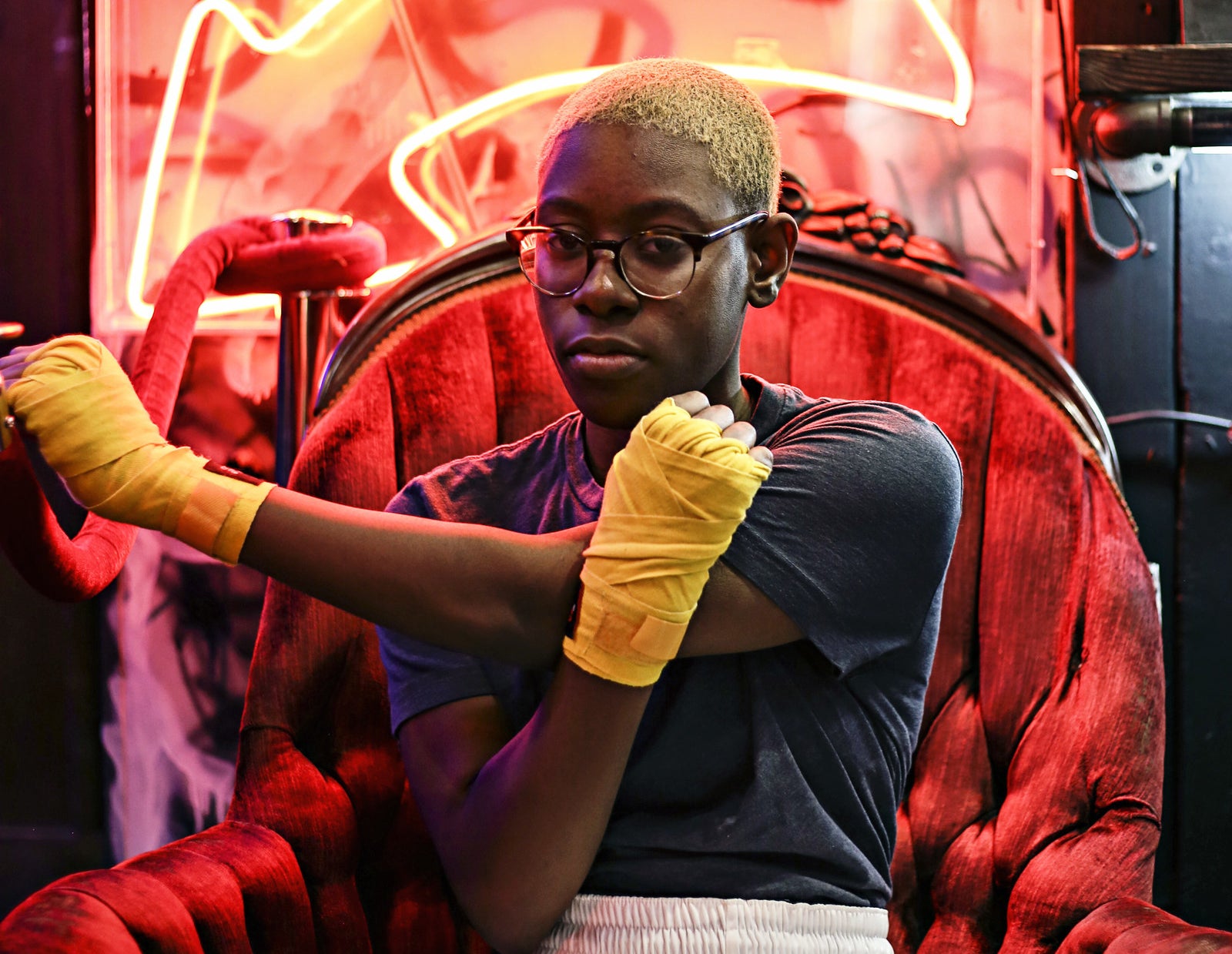
That boxing could be a “safe space” may seem antithetical for a sport built around beating one’s opponent down until they literally throw in the towel. But boxing, and boxing gyms, have long functioned as a place of refuge. In America, boxing has its roots in working-class, minority communities: black, Italian, Irish, Latino. It has taken in the very bodies that society dismisses, or fears, or brutalizes.
In his book Body & Soul, Loïc Wacquant wrote that during his time at a boxing gym on Chicago’s South Side, his trainer told him that if anyone wanted to know who was at the bottom of society, they just had to look to see who was boxing. Boxers strive to protect the most vulnerable parts of themselves as another person goes in for the knockout; it seems, on some level, only natural that the sport would speak to those who know what it means to inhabit a body under siege.
Now, however, boxing is also speaking to the masses; in the past two years, the sport has become increasingly trendy. There are boxing gyms clustered throughout New York City, and ClassPass offers sessions at 183 of them. Aerospace, a popular spot for Victoria’s Secret models, charges $25 per class. Overthrow normally charges $34, which is nearly as much as what the boxing gym Hanson goes to in Bed-Stuy charges in a month. Hanson was eye-rollingly critical of this burgeoning movement, calling those who treat boxing as a fitness trend “a yuppie, bourgeoisie class of people.”
“These are not the people that this sport is for,” Hanson stressed. “People in dominant groups — cis, hetero, white, male — they’re not used to feeling uncomfortable. They’re not used to feeling not OK. And when you box, you have to be used to not feeling OK. It doesn’t feel OK a lot of the time. That’s why this sport, for people of color, has been huge. And that’s what I’m trying to communicate to trans people: This is uniquely suited for you, because we are used to being uncomfortable.”
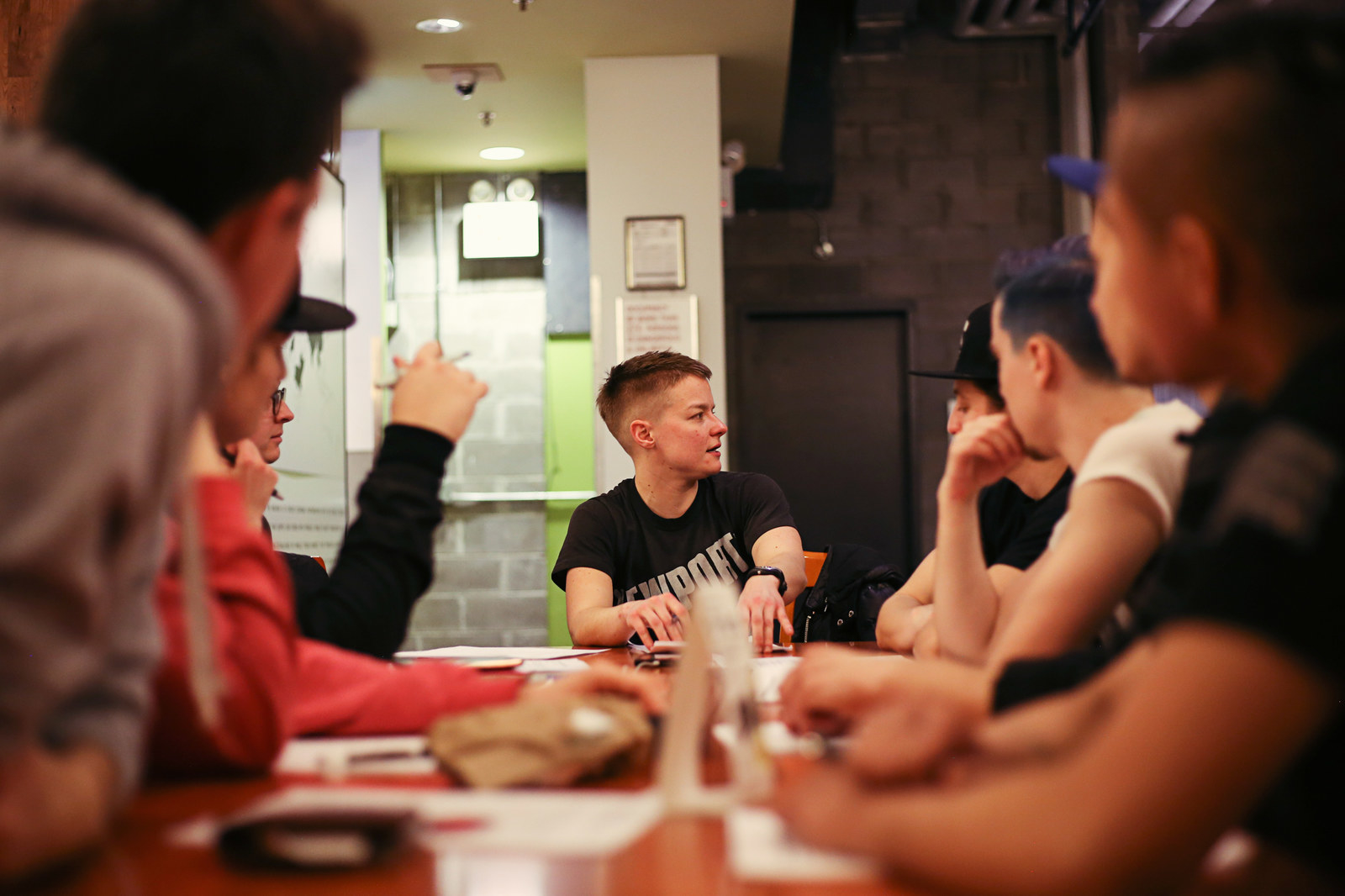
The National Transgender Discrimination Survey found that 78% of trans and gender-nonconforming students in grades K–12 have experienced harassment. A study from the Human Rights Campaign and Trans People of Color Coalition estimated that trans women in the US were 4.3 times more likely to be murdered than cis women, and that nearly 90% of trans people murdered from 2013 to 2015 were people of color.
“I get a lot of assaults from people,” Gaines said. “And I don’t have any way to handle that. For me, boxing is more psychological. It’s where I can take back what people take from me on a daily basis. The people who are cruel to me, I can take that aggression that I have for them and put it in the gym.”
At its core, Hanson believes, boxing is more about understanding the self than it is about defending it. About learning how much a body can lose, and discover, and endure. The goal of a safe space, Hanson said, is not avoiding pain. “But how do we create a container where it’s safe to feel pain?” they asked. “It’s not about giving pain to people; it’s not about inflicting suffering. It’s about allowing yourself to hold a great deal of pain and still stand up.”
Near the end of the collective’s quarterly meeting at the café, Jessica, a member who frequently comes to class with a shirt announcing “Gender Is Over,” suggested that new trainers be told to address people in the group as “they/them” in order to avoid unintentionally misgendering anyone.
Without warning, an older man who had been sitting at the next table over started yelling anti-gay slurs at the group. Everyone at the table tensed; a few people looked down studiously, others immediately cut their eyes toward the man. “It’s OK — it’s not worth it,” someone said quietly.
Hanson waited for a few minutes, body alert, assessing the situation, before leaving their seat to flag a security guard, who escorted the man out.
“Anyone can hit,” Hanson had told me earlier. “Boxing is not about hitting. It’s about moving your body, shifting, letting punches go.” About learning how to navigate through the world.
After the man left, Hanson went back to the agenda for a few minutes before pausing and looking up. “Is everyone OK?”
There were smiles, some shaky. Everyone at the table took a few breaths to center themselves from the blow, and then they went on. ●
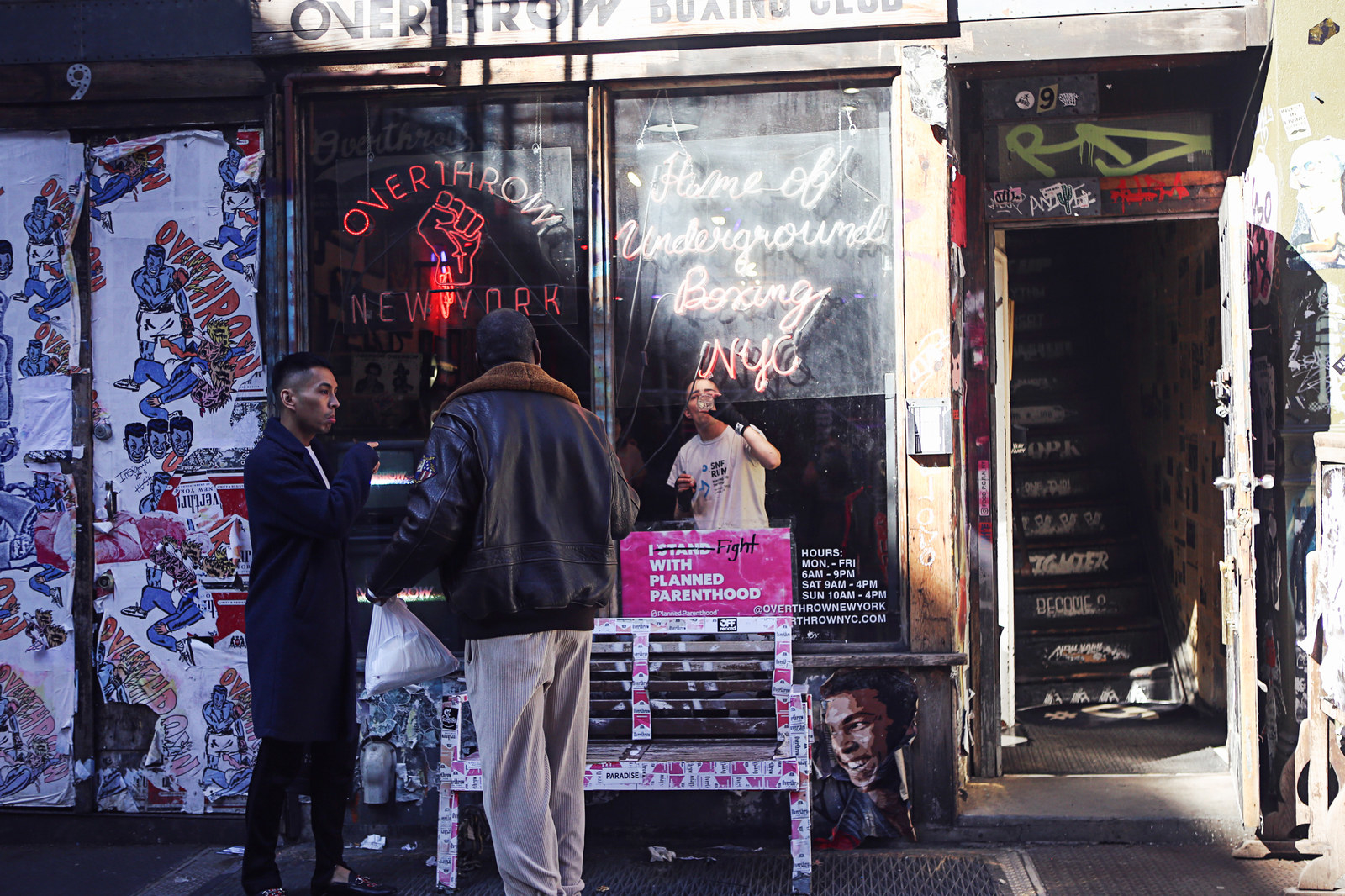
Teresa Mathew is a writer and photojournalist focusing on race, religion, and resilience.
